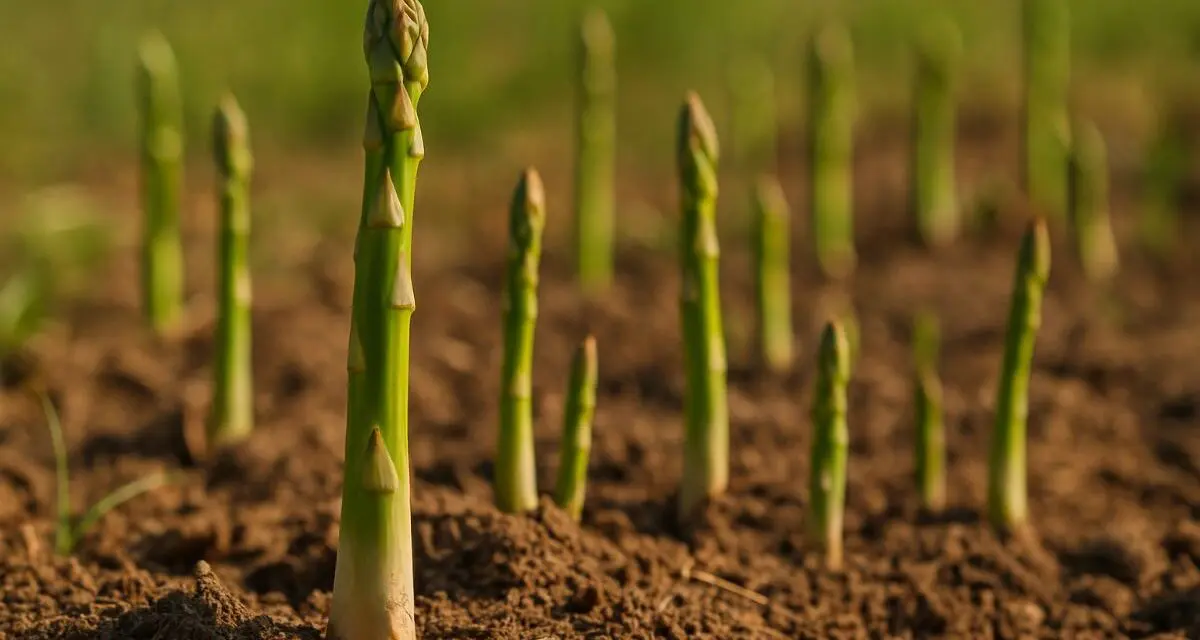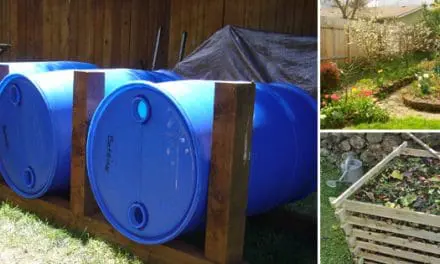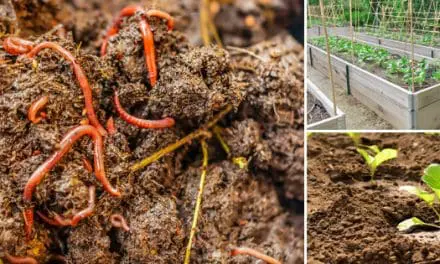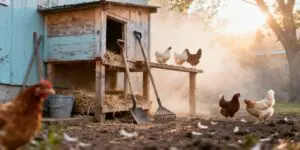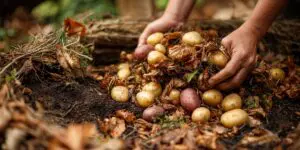Choosing where to plant asparagus might be the most important gardening decision you’ll make this decade. Unlike annual vegetables that give you a do-over each season, asparagus location is a commitment that will define your harvest for the next three decades. Get it right, and you’ll enjoy fresh asparagus spears every spring for 20-30 years. Get it wrong, and you’ll struggle with poor yields, disease problems, and the heartbreak of starting over.
The secret to asparagus success lies in understanding that asparagus is a perennial crop with specific, non-negotiable requirements. This comprehensive guide will walk you through every factor you need to consider when deciding where to plant asparagus, from soil conditions to long-term garden planning.
Key Takeaways
- Plant asparagus in full sun locations with well-drained soil and pH between 6.5-7.0
- Choose a permanent spot since asparagus beds produce for 15-30 years
- Avoid low-lying, frost-prone areas and locations with poor drainage
- Space asparagus beds at the north end of gardens to prevent shading other crops
- Plant crowns in early spring (May-June in northern climates) in trenches 6-12 inches deep
- Allow 3-6 feet between rows and 12-18 inches between individual plants
Choosing the Perfect Location for Your Asparagus Bed
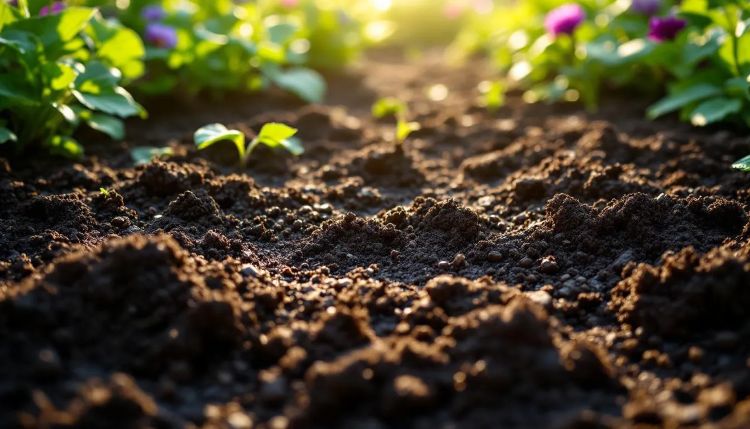
The foundation of successful asparagus growing starts with selecting the right location. Asparagus plants demand full sun exposure, requiring at least 6-8 hours of direct sunlight daily for optimal spear production. Partial shade dramatically reduces yields – sometimes by 50% or more – making sun exposure your top priority when evaluating potential planting sites.
When considering where to plant asparagus, think about your garden’s layout both now and in the future. Mature asparagus ferns reach 4-6 feet tall and spread 3-4 feet wide, creating dense shade that can negatively impact shorter neighboring crops. Position your asparagus bed at the north or northeast edge of your vegetable garden to minimize shading issues.
Avoid locations under trees or near large shrubs. Not only do these areas lack sufficient sunlight, but tree roots create intense competition for water and nutrients. Since asparagus roots can extend 6 feet deep, they need access to the full soil profile without interference from established woody plants.
Permanence is crucial when selecting your planting site. The asparagus bed will occupy the same space for decades, so consider potential changes to your property. Will future construction, landscaping projects, or utility work affect the area? Choose a location that offers easy access for annual maintenance and harvesting while remaining isolated from activities that might disturb the sensitive root system.
Soil Requirements and Site Preparation
The success of your asparagus patch depends heavily on soil quality and drainage. Well-drained soil is absolutely essential – asparagus crowns and roots cannot tolerate standing water or persistently wet conditions, which quickly lead to root rot and plant death.
Soil Drainage and Texture
Sandy loam represents the gold standard for growing asparagus, but the plant will adapt to heavier soils if drainage is adequate. Heavy clay soils require amendment with compost or well-rotted manure to improve structure and drainage. If your garden has drainage issues, consider creating raised beds or ridges to ensure proper water movement.
Test your soil’s drainage by digging a hole 12 inches deep and filling it with water. If water remains after 24 hours, the location needs drainage improvement before planting asparagus crowns.
Soil pH Requirements
Asparagus thrives in neutral to slightly alkaline conditions, with an optimal soil pH range of 6.5-7.0. The plant tolerates slight variations, but acidic soils below pH 6.5 can limit growth and production significantly.
Conduct a soil test 2-3 months before planting to determine your current pH and nutrient levels. If pH adjustment is needed, apply lime to raise acidic soil or sulfur to lower alkaline soil. These amendments need time to alter soil chemistry effectively.
Fertility and Nutrition
Asparagus has high phosphorus and potassium requirements, especially during establishment. Based on your soil test results, incorporate these nutrients before planting crowns:
- Phosphorus: Essential for root development. Apply bone meal or super phosphate at rates recommended by soil test results
- Potassium: Supports overall plant vigor and disease resistance
- Organic matter: Add 2-4 inches of compost or composted manure to improve soil structure and fertility
A balanced organic fertilizer with equal parts nitrogen, phosphorus, and potassium works well for initial soil preparation. Avoid high-nitrogen fertilizers at planting time, as they can promote excessive foliage growth at the expense of root development.
Climate Considerations and Timing

Understanding your climate is crucial for asparagus success. Garden asparagus (Asparagus officinalis) performs best in USDA hardiness zones 2-9, thriving in temperate regions with distinct seasons and adequate winter chill hours.
Winter Chill Requirements
Asparagus requires a dormant period with temperatures below 45°F for 12-16 weeks to produce robust spear crops. Without adequate chilling, asparagus plantings may produce fewer, smaller spears with reduced quality. This requirement makes asparagus challenging to grow in subtropical regions without sufficient winter cold.
Planting Timing
Plant asparagus crowns in early spring when soil is workable but frost danger hasn’t completely passed. Timing varies by region:
- Northern climates (zones 2-5): Late April to early June
- Central regions (zones 6-7): March to early May
- Southern areas (zones 8-9): February to March
Avoid planting in areas prone to late spring frosts. Emerging spears are highly susceptible to cold damage, and repeated frost injury can weaken newly planted crowns significantly.
Seasonal Considerations
The growing season for asparagus extends from early spring emergence through fall when asparagus ferns naturally die back. During this period, the plant builds energy reserves in its extensive root system for next year’s spear production.
Plan your planting site to accommodate this long growing cycle. The location should remain undisturbed throughout the entire growing season, allowing asparagus ferns to photosynthesize and strengthen the root system.
Spacing and Layout Planning
Proper spacing ensures healthy plant development and easy maintenance access. Standard recommendations for asparagus planting include:
Row and Plant Spacing
- Between plants: 12-18 inches apart within rows
- Between rows: 3-6 feet for conventional spacing
- Intensive spacing: 6-12 inches apart in single rows for small gardens
A typical backyard asparagus bed measuring 4×8 feet can accommodate 16-25 crowns using intensive spacing methods. For larger installations, calculate approximately 36-100 square feet for 25 crowns, depending on your chosen spacing method.
Layout Considerations
When planning your asparagus bed layout, consider these factors:
- Access paths: Maintain 2-3 feet of clear space around the bed for harvesting and maintenance
- Future expansion: Leave room for potential bed expansion as your asparagus appreciation grows
- Companion planting: Low-growing, shallow-rooted plants like strawberries can coexist with asparagus if managed carefully
Male and female plants require the same spacing, though male asparagus plants typically produce more spears since they don’t divert energy into seed production. Modern hybrid varieties often emphasize male plants for this reason.
Areas to Avoid When Planting Asparagus
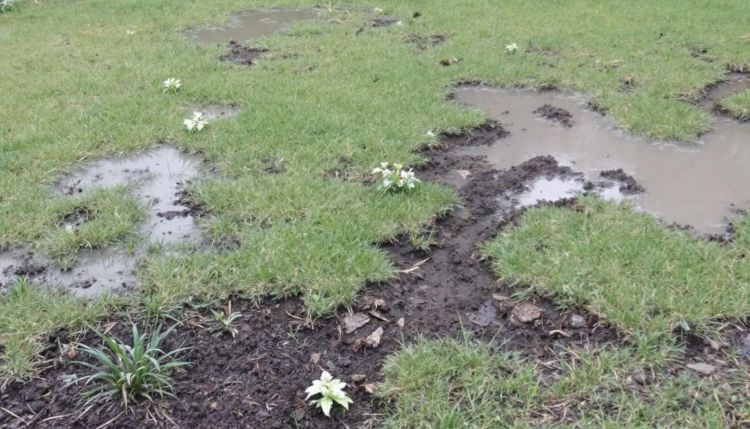
Certain locations spell disaster for asparagus regardless of other growing conditions. Avoid these problematic areas:
Drainage Problem Areas
- Low-lying spots where water collects after rain or snowmelt
- Areas near downspouts or other water concentration points
- Compacted soil zones where water movement is restricted
- Clay hardpan locations that prevent deep root penetration
Microclimate Issues
- Frost pockets in valleys or depressions where cold air settles
- Wind tunnels that can damage emerging spears and mature ferns
- Areas with poor air circulation that encourage fungal diseases like asparagus rust
Competition and Interference
- Near large trees with extensive root systems
- Close to aggressive perennial weeds like quackgrass or bindweed
- Slopes steeper than 15% where soil erosion threatens crown stability
- Previously used asparagus sites where soil-borne pathogens may persist
Infrastructure Conflicts
Avoid planting near utility lines, septic systems, or areas where future construction might occur. Remember that asparagus beds are essentially permanent installations that shouldn’t be moved once established.
Preparing the Planting Site
Thorough site preparation sets the foundation for decades of productive harvests. Begin preparation several months before your planned planting date to ensure optimal conditions.
Weed Elimination
Removing perennial weeds is perhaps the most critical preparation step. Weeds like dandelions, quackgrass, and bindweed must be completely eliminated before planting asparagus crowns. These aggressive perennials can quickly overwhelm young asparagus plants and are nearly impossible to remove once the bed is established.
Methods for weed control include:
- Mechanical removal: Dig out entire root systems
- Solarization: Cover the area with clear plastic for 6-8 weeks during hot weather
- Smothering: Use cardboard and mulch to kill existing vegetation over one growing season
Soil Preparation
Once weeds are eliminated, prepare the soil by:
- Deep cultivation: Work the soil 12-15 inches deep to ensure proper drainage and root penetration
- Organic matter incorporation: Mix in 2-4 inches of compost or well-rotted manure
- Fertilizer application: Add phosphorus and potassium based on soil test recommendations
- Final grading: Create slight ridges or raised areas to enhance drainage
Trench Preparation
When ready to plant crowns, dig a trench 6-12 inches deep depending on your soil type. Use deeper trenches in sandy soils and shallower ones in clay. The trench should be wide enough to spread asparagus roots without crowding.
Long-term Site Considerations
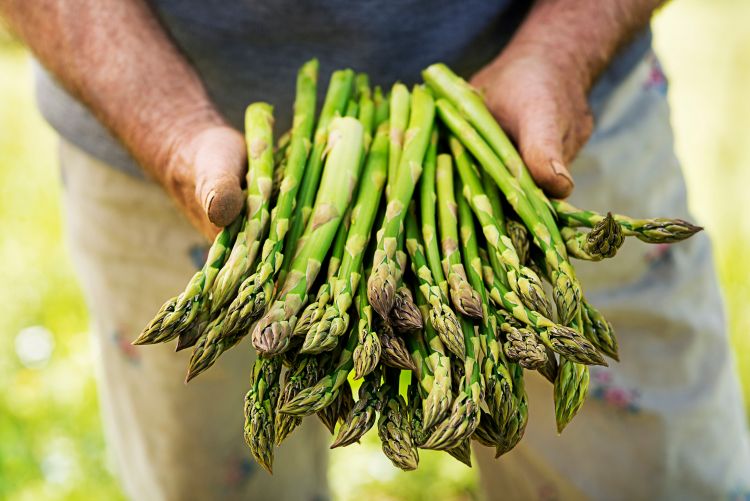 Planning for the long term is essential when establishing an asparagus bed. Consider these factors that will affect your planting for decades:
Planning for the long term is essential when establishing an asparagus bed. Consider these factors that will affect your planting for decades:
Mature Plant Requirements
Asparagus plants change dramatically as they mature. What starts as small crowns becomes substantial plants requiring significant space. Plan for:
- Fern height: 4-6 feet tall at maturity
- Spread: 3-4 feet wide per plant
- Root expansion: Extensive root systems spreading 6+ feet deep and wide
Maintenance Access
Ensure permanent access for:
- Daily harvesting during the 6-8 week harvest season
- Annual fertilization and soil amendment
- Weed control throughout the growing season
- Fall cleanup when cutting back dead ferns
Garden Evolution
Consider how your garden might change over time:
- Tree growth that could create future shade
- Property improvements that might affect drainage or access
- Changing gardening interests that might alter surrounding plantings
Irrigation Planning
Establish efficient watering systems early. Consistent soil moisture is crucial for asparagus, especially during establishment and dry periods. Drip irrigation or soaker hoses work well for delivering deep, consistent moisture without wetting foliage.
FAQ
Q: Can I plant asparagus in partial shade? A: Asparagus needs full sun (6+ hours) for optimal production; partial shade reduces yields significantly. Shade locations may produce 50% fewer spears with reduced quality.
Q: How deep should I plant asparagus crowns? A: Plant 6-12 inches deep depending on soil type – deeper in sandy soils, shallower in clay. Cover crowns with 2 inches of soil initially, gradually backfilling as shoots emerge.
Q: Can I move an established asparagus bed? A: Moving is difficult due to deep roots extending 6+ feet; it’s better to start a new bed in the desired location. Transplant asparagus success rates are very poor even with careful handling.
Q: What’s the minimum space needed for asparagus? A: A 4×4 foot area can accommodate 9-16 crowns using intensive spacing methods, though yields per crown may be reduced compared to conventional spacing.
Q: Should I plant asparagus near my house? A: Yes, if the location gets full sun and has good drainage; proximity makes harvest and seasonal care more convenient. Just ensure adequate space for mature fern growth.
Q: Can asparagus grow in containers? A: Large containers (20+ gallons) work but require excellent drainage and consistent watering. Container yields are significantly lower than in-ground asparagus beds.
Q: How do I know if my soil drains well enough? A: Dig a test hole 12 inches deep, fill with water, and check drainage after 24 hours. If water remains, improve drainage before planting or consider raised beds.
Q: When can I start harvesting asparagus spears? A: Avoid harvesting newly planted crowns for the first two years. Begin light harvesting in year three, with full production starting in year four when plants are well-established.
Selecting the perfect location for your asparagus bed requires careful consideration of multiple factors, but the investment in proper site selection pays dividends for decades. Take time to evaluate your options thoroughly, prepare the soil properly, and choose a location that will serve your asparagus plants – and your family’s dinner table – for the next 30 years.
How to Grow Ginger – A Self-Reliant Guide for Backyard Growers
Whatever You Do, Don’t Chop Down This Backyard Tree (Video)
Does Potting Soil Go Bad? The “Simple” Answer!

